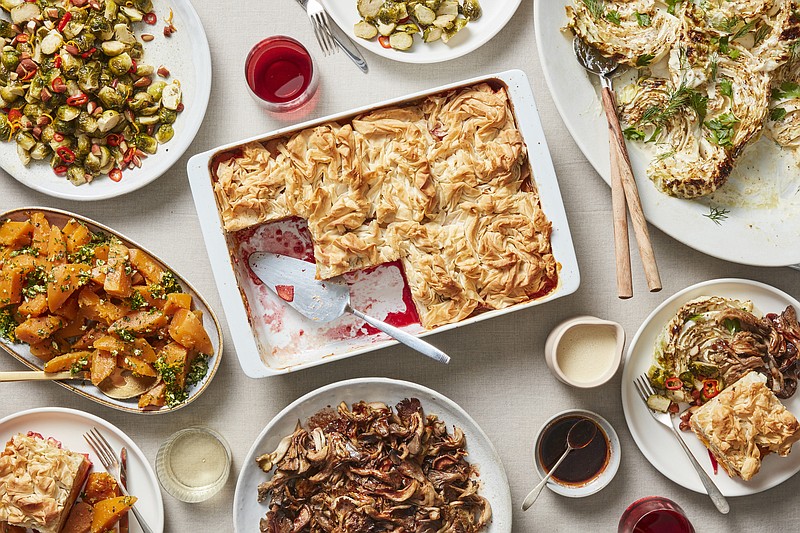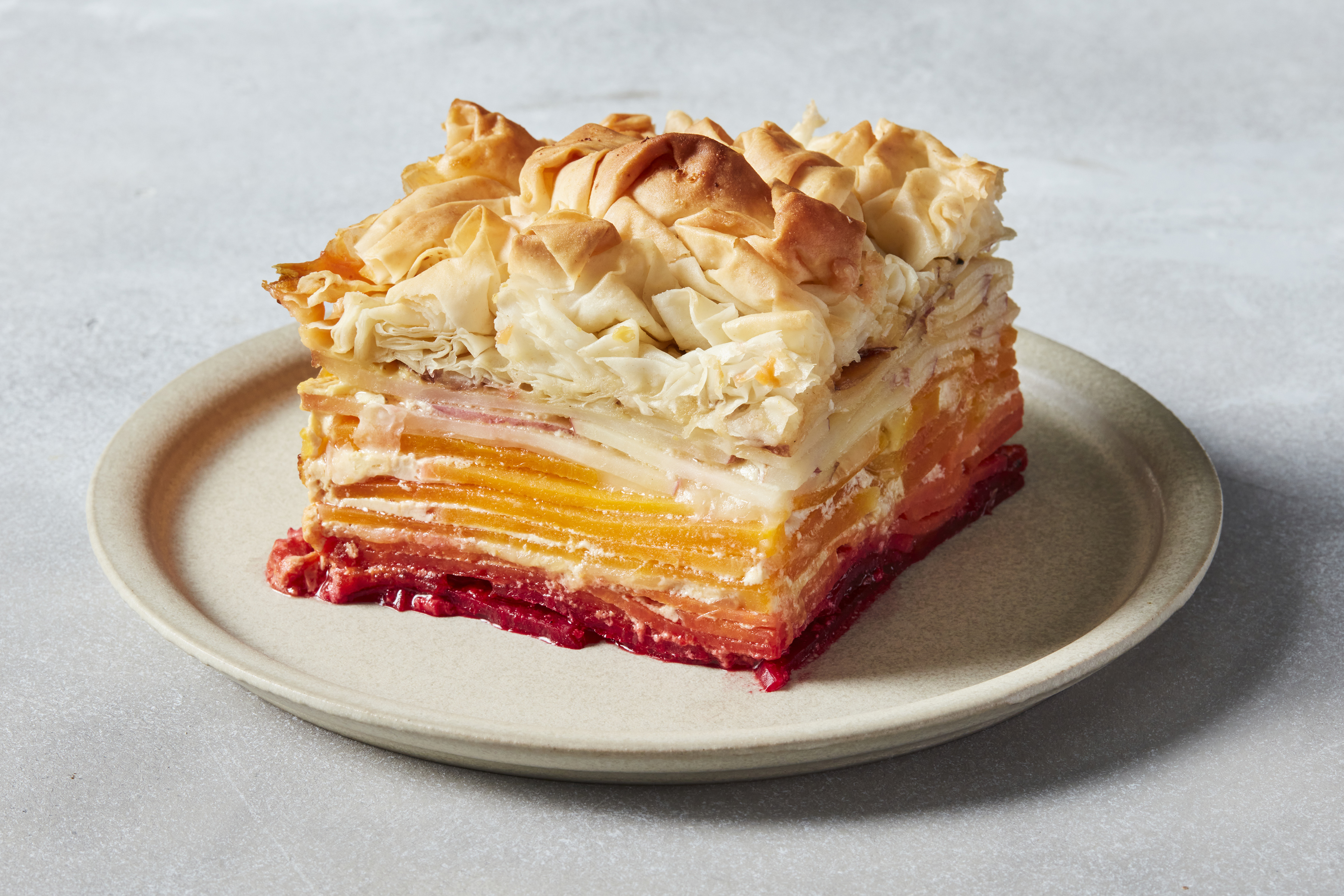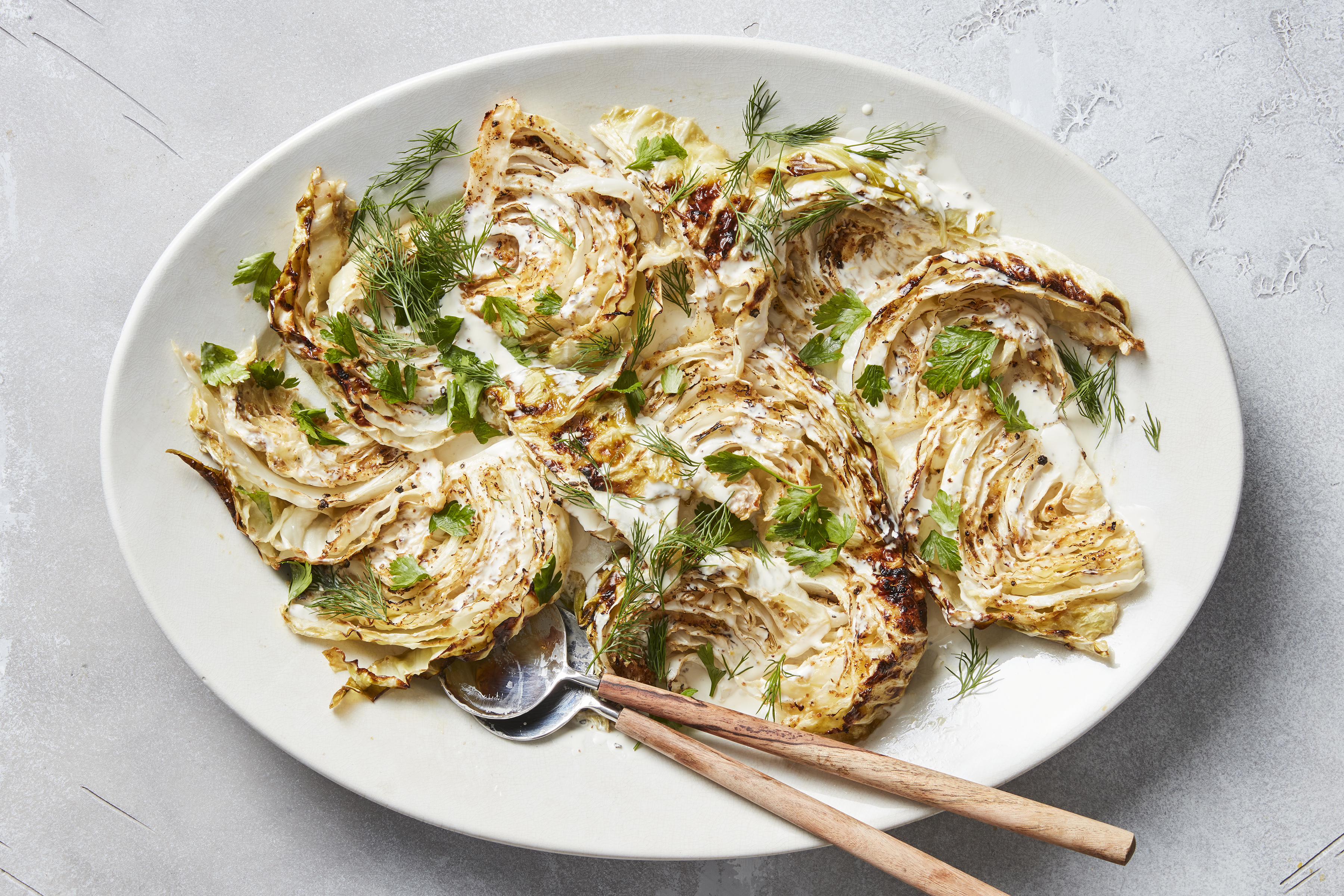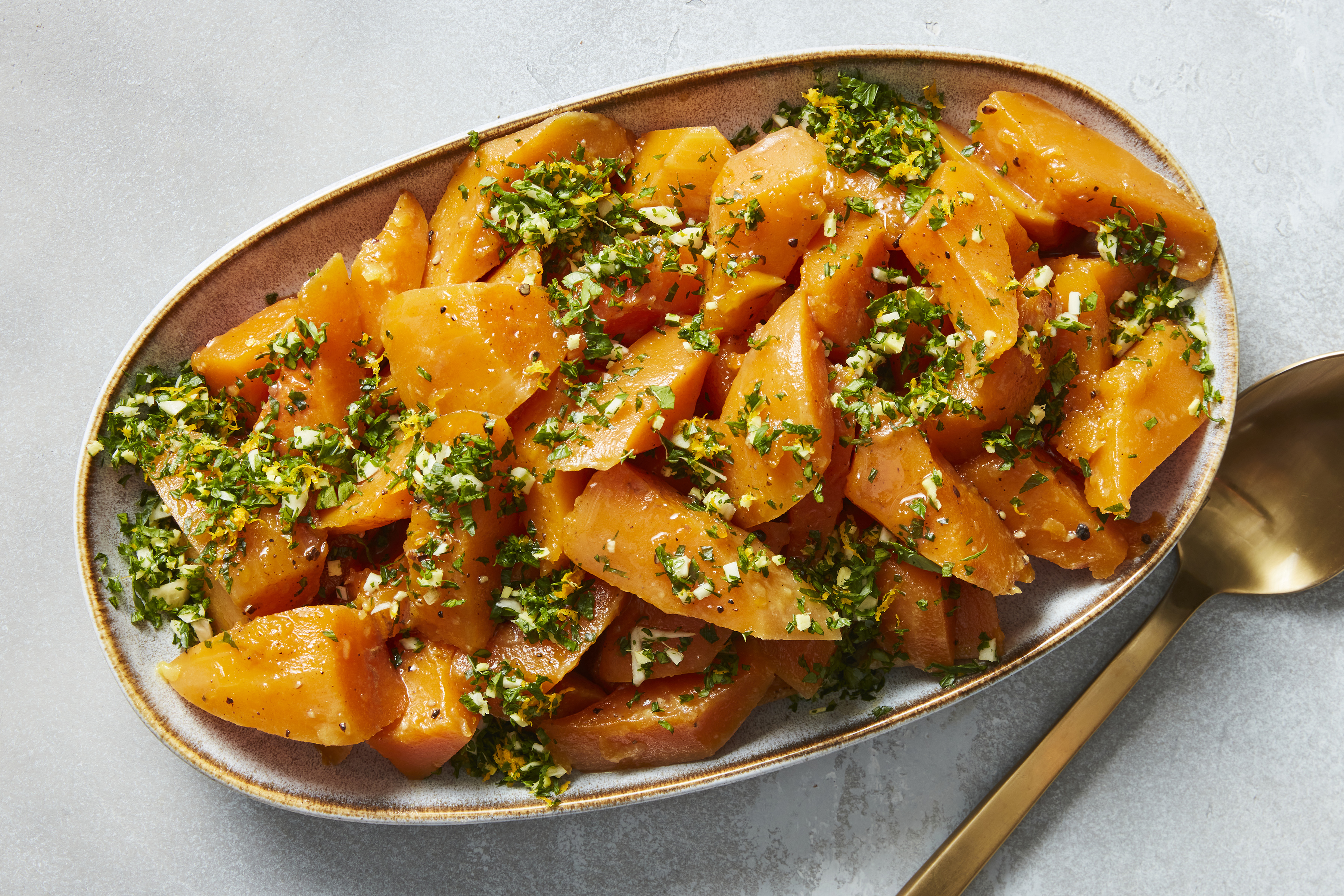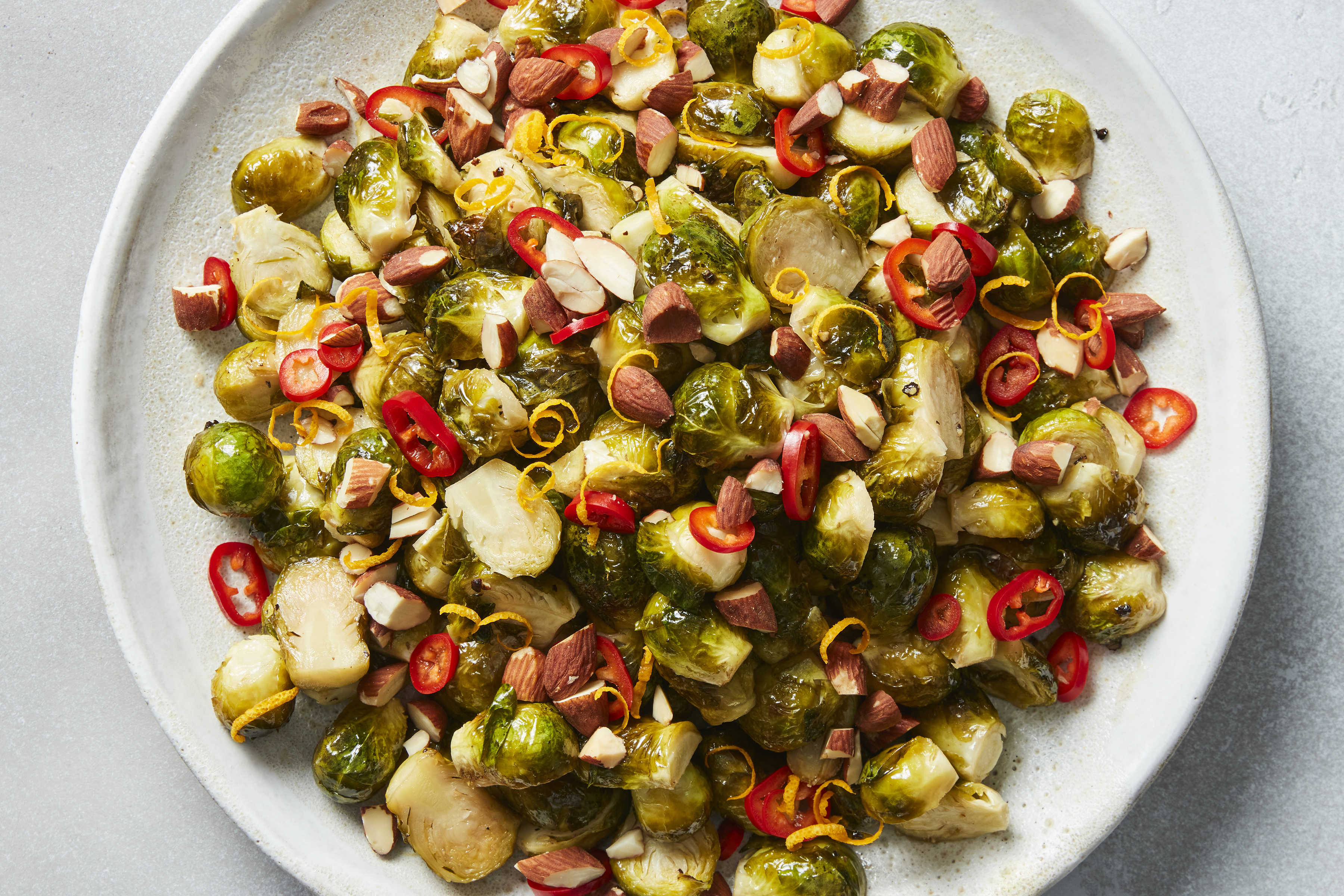Vegetables star in these five new dishes that were made for vegetarians and created to appeal to everyone. Maybe you're adopting a meatless holiday meal for the first time or maybe you have never felt tethered to turkey and are finally skipping the bird this year because of its increasingly high cost. These recipes provide the richness, comfort and abundance you expect from Thanksgiving: deep, roasted caramelized flavor embellished with bursts of acidity from citrus, hints of heat and some welcome levity from fresh herbs.
At the heart of this celebration of vegetables is an ornate ombre gratin with enough ceremonial pomp to create a stir. The four accompanying side dishes are easier to put together, but taste just as special. You can prepare the whole feast or weave the dishes into your menu. There's always room for more at the table.
Ombre Gratin
Thinly sliced potatoes, butternut squash, sweet potatoes and beets are baked in an herbed cream until positively lush and then capped with a crispy phyllo frill. Slice the gratin at the center of your table to reveal the Technicolor stack of fork-tender vegetables.
Yield: 12 servings
Total time: 3 hours
For the cream:
3 tablespoons unsalted butter, plus more for greasing the dish
1 1/2 cups finely chopped shallots (from 4 large shallots)
8 garlic cloves, finely chopped
2 tablespoons whole black peppercorns
4 cups half-and-half
8 fresh or dried bay leaves
2 tablespoons fresh thyme leaves
3/4 teaspoon grated nutmeg
1 1/2 teaspoons kosher salt (such as Diamond Crystal)
3 large egg yolks
For the vegetables:
2 1/2 pounds red potatoes (about 6 medium red potatoes), scrubbed
Kosher salt (such as Diamond Crystal) and black pepper
2 large beets (about 6 ounces each)
10 ounces Gruyère, grated (about 4 cups)
2 large sweet potatoes (about 10 ounces each), peeled, halved lengthwise and sliced into 1/8-inch-thick slices (see tip)
2 pounds butternut squash (the neck of 1 squash), peeled, quartered lengthwise and sliced into 1/8-inch-thick slices (see tip)
For the phyllo top:
1/2 cup plus 2 tablespoons unsalted butter
16 phyllo pastry sheets, thawed
Set a rack in the middle of the oven and another right below it. Heat the oven to 375 degrees. Grease a 13- by 9-inch baking dish with butter; set aside.
Prepare the cream: In a large saucepan, melt the butter over medium-low. Add the shallots, garlic and black peppercorns, and cook, stirring occasionally, until shallots are softened, about 5 minutes. Stir in the half-and-half, bay leaves, thyme, nutmeg and 1 1/2 teaspoons salt, and bring to a simmer over medium-high. Reduce the heat to maintain a low simmer, and cook, whisking occasionally, until slightly thickened, about 20 minutes.
Strain the seasoned cream through a fine-mesh sieve into a large bowl. (You should have about 3 cups.) Return the cream to the saucepan off the heat. In the same bowl, whisk the egg yolks, then whisk in a few tablespoons of the warm cream, 1 tablespoon at a time, to temper the yolks. (Tempering prevents the cold yolks from scrambling when combined with the warm cream. The yolks will help your filling hold together.) Whisk the egg yolk mixture into the cream. Reserve and refrigerate 1 cup cream for serving. Rinse and dry the bowl.
Using a mandoline (or very sharp knife; see tip), slice the unpeeled red potatoes crosswise 1/8-inch thick. In the bowl, toss the potatoes with 1 1/2 teaspoons salt and 3/4 teaspoon pepper until evenly seasoned, then stir the potatoes into the cream in the saucepan. (The warmth of the cream will help the potatoes start to cook.) Set aside.
Peel, trim and halve the beets, then slice them 1/8-inch thick using a mandoline (or very sharp knife; see tip). Add the beets to the bowl, and toss with 3/4 teaspoon salt and 1/4 teaspoon pepper. Shingle the sliced beets in the baking dish, overlapping slightly, in two even layers, then sprinkle them evenly with 1 1/3 cups grated Gruyère. Wipe out the bowl to remove any beet juices.
In the bowl, season the sliced sweet potatoes with 1 teaspoon salt and 1/4 teaspoon pepper; toss to coat. Shingle them on top of the cheese-topped beets in 2 to 3 even layers, then press them gently to compress the vegetables evenly, eliminating any air pockets. Sprinkle the sweet potatoes with 1 1/3 cups grated Gruyère.
In the bowl, season the squash with 3/4 teaspoon salt and 1/4 teaspoon pepper; toss to coat. Shingle the squash over the cheese-topped sweet potatoes in 2 even layers, press to compress the mixture, then sprinkle the squash with the remaining 1 1/3 cups grated Gruyère.
Shingle the potatoes on top in 2 to 3 even layers, then slowly pour the remaining cream mixture evenly over the sliced vegetables. Set on the middle rack of the oven, and place a large sheet pan directly underneath on the rack below to catch any drips. Bake until the vegetables start to soften, about 1 hour.
After the vegetables have baked for about 40 minutes, prepare the phyllo: In a small saucepan, melt the butter over medium-low heat. Working on a large, clean surface, set 1 sheet of phyllo down. Brush lightly with melted butter then set a second sheet of phyllo on top. Take your hands and scrunch the phyllo into a 5 1/2-inch rosette with lots of folds. Push aside, then repeat with remaining 14 sheets of phyllo, creating 8 rosettes total.
After the sliced vegetables have cooked for 1 hour, remove from the oven. Increase heat to 400 degrees. Using a paper towel, gently pat the surface to remove any liquid that may have risen to the surface, then cover the top with the 8 phyllo rosettes, scrunching them as needed to fit. Brush the phyllo generously with melted butter.
Bake until the phyllo is crisp and golden and the vegetables are tender and a paring knife slides easily through the center, about 30 minutes. Let cool for 20 to 30 minutes before slicing. (Patience is crucial; if you slice this before the liquids are reabsorbed, the gratin won't form slices without slipping apart.)
While the gratin firms up, reheat the reserved cream over medium until warmed through, about 2 minutes. Season the warm sauce with salt and pepper.
To serve, cut the gratin in half lengthwise, then cut crosswise to form 12 even slices. Pass the sauce at the table, to spoon on the side.
Tip: In order for the vegetables to be tender by the time the phyllo is crispy and golden, they must be sliced 1/8-inch thick. A mandoline makes fast work of vegetable slicing and creates uniformly thin pieces, though you could use a very sharp knife (and an abundance of caution) when slicing the dense vegetables. Japanese Benriner slicers are restaurant staples and are affordable tools for home cooks, too.
Roasted Mushrooms With Smoky Pomegranate Sauce
Most roasted mushroom recipes sacrifice moisture for the benefit of crisp edges -- but not this one. Oyster mushrooms get treated to an oven steam-roast approach: They're first covered in foil and baked gently to retain moisture, then broiled until golden, which allows them to caramelize while remaining plump and tender. A pomegranate sauce provides ample acidity to cut through the mushrooms' richness.
Yield: 6 to 8 servings
Total time: 50 minutes
For the mushrooms:
1/4 teaspoon poultry seasoning
1/4 teaspoon granulated onion
1 1/2 teaspoons kosher salt (such as Diamond Crystal)
1 teaspoon black pepper
4 tablespoons extra-virgin olive oil, plus more for brushing
3 pounds oyster mushrooms, torn into small clusters, or other mushrooms (see tip)
6 small fresh rosemary sprigs
For the pomegranate sauce:
3 tablespoons unsalted butter or vegan alternative
1 large shallot, minced
1 dried ancho chile, torn into big pieces, seeds and stem discarded
2 large garlic cloves, minced
4 teaspoons whole black peppercorns, coarsely crushed using the flat side of a knife
Kosher salt (such as Diamond Crystal)
1 teaspoon vegetable stock concentrate (such as Better Than Bouillon), optional
2 cups pomegranate juice
Heat the oven to 425 degrees and set a rack closest to the broiler.
Prepare the mushrooms: In a small bowl, stir together the poultry seasoning, granulated onion, salt and pepper. Lightly brush 2 large sheet pans with olive oil to coat. Divide the mushrooms among sheet pans. Drizzle each batch with 2 tablespoons olive oil, then gently toss to coat. Sprinkle the mushrooms evenly with the spice blend and toss to coat again. Tuck the rosemary sprigs among the mushrooms, wrap tightly with aluminum foil and set both sheet pans in the oven to tenderize the mushrooms, about 25 minutes.
While the mushrooms steam, prepare the pomegranate sauce: In a medium saucepan, heat the butter over medium until melted. Stir in the shallot, chile, garlic and peppercorns. Season with 1/4 teaspoon salt and cook, stirring frequently, until fragrant and softened, about 5 minutes. Stir in the stock concentrate (if using), then pour in the pomegranate juice and cook over medium-high, whisking occasionally, until the liquid is the consistency of maple syrup and thick enough to coat a spoon, 15 to 20 minutes. Strain through a fine-mesh sieve, pushing on the solids to extract any liquid. You should have about 1/2 cup sauce, which will keep, refrigerated, for up to 2 days.
After the mushrooms have steamed, heat the broiler to high. Pull the mushrooms from the oven and remove the foil. Working with 1 sheet pan at a time, return the mushrooms to the rack nearest the broiler and cook, uncovered, until browned and caramelized at the edges, 4 to 6 minutes.
Discard rosemary and season mushrooms to taste. Arrange the mushrooms on a serving platter. Drizzle lightly with pomegranate sauce, passing the remaining sauce at the table.
Tip: You also can use a mix of mushrooms that total 3 pounds and are prepared so they're all about the same size. If using fresh shiitakes, stem and halve them. If using creminis, trim and quarter them.
Roasted Cabbage Wedges With Lemon Vinaigrette
Roasted cabbage is a revelation: High heat transforms the cruciferous vegetable, rendering it silky, tender and yielding. Inspired by leeks vinaigrette, these wedges are brushed with a lemon-mustard vinaigrette, chilled, then topped with a crème fraîche dressing and fresh herbs before serving. This salad-disguised- as-a-side is a boon to busy cooks, as it tastes best when made ahead and chilled, bringing an unexpected cooling element to the table.
Yield: 8 servings
Total time: 45 minutes, plus overnight chilling
For the roasted cabbage:
1 medium head green cabbage (2 1/2 to 2 3/4 pounds)
1/2 cup extra-virgin olive oil
1 teaspoon finely grated fresh lemon zest plus 2 tablespoons juice
2 tablespoons coarse mustard
1 tablespoon honey
2 large garlic cloves, finely grated (2 teaspoons)
Kosher salt (such as Diamond Crystal) and black pepper
For the dressing:
1/2 cup crème fraîche or sour cream
1/4 cup mayonnaise
1 lemon, zested plus 2 tablespoons lemon juice
Kosher salt and black pepper
Torn fresh dill and parsley, for garnish
Heat oven to 450 degrees.
Prepare the cabbage: Peel any wilted outer leaves, then halve the cabbage lengthwise through the core, setting both halves flat on your cutting board. Slice them through the core into 12 even wedges (each about 1 1/4 inches thick at the widest point). Gently transfer them to a large sheet pan, carefully keeping each wedge intact.
In a small bowl, whisk together the olive oil, lemon zest and juice, mustard, honey, garlic, 1/2 teaspoon salt and 1/4 teaspoon pepper. Brush half the vinaigrette over the cabbage wedges, making sure it drips between the leaves, then carefully flip the wedges over and brush with the remaining vinaigrette.
Roast the cabbage until tender, golden at the edges and caramelized, 25 to 30 minutes.
While the cabbage roasts, prepare the dressing: In a small bowl, whisk together the crème fraîche, mayonnaise, lemon zest and juice; season to taste with salt and pepper. (If using sour cream, thin the dressing with just enough water so that it can be drizzled, about 1 tablespoon.) Refrigerate for up to 2 days.
Let the cabbage cool, then refrigerate it for up to 2 days. Arrange the cabbage wedges on a serving platter. Season to taste. Serve cold or at room temperature, drizzled with the dressing (brought to room temperature) and garnished with the dill and parsley.
Ginger Beer-Glazed Butternut Squash With Gremolata
Any successful Thanksgiving strategy involves a menu that doesn't overburden the oven. In this stovetop dish, squash simmers with a mixture of ginger beer, vegetable stock, honey, butter and cloves. Like many glazed recipes, this one showcases the beauty of great timing: When the squash is done cooking, the liquid will have reduced to a glossy sauce. A confetti-like gremolata of chopped ginger, garlic, parsley and orange zest makes for a cold-weather side that sparkles.
Yield: 8 servings
Total time: 30 minutes
2 cups ginger beer
3/4 cup vegetable stock, plus more if needed
1 medium (3-pound) butternut squash, peeled, seeded and cut into 1-inch jewel-shaped chunks
3 tablespoons unsalted butter
1 tablespoon honey
1/8 teaspoon ground cloves (optional)
Kosher salt (such as Diamond Crystal) and black pepper
2 tablespoons finely chopped fresh parsley leaves
1/2 teaspoon finely chopped fresh ginger
1/4 teaspoon finely chopped fresh garlic
1/4 teaspoon finely grated fresh orange zest
Add the ginger beer and stock to a large, deep skillet. Bring to a boil over high.
Add the squash in an even layer. Top with the butter, honey and cloves (if using), and season with 1/2 teaspoon salt and 1/4 teaspoon pepper. Reduce the heat to medium-high, and cook, stirring occasionally, until the squash is tender and the sauce thickens to a glaze, about 25 minutes.
While squash simmers, prepare the gremolata: Chop the parsley, ginger, garlic and orange zest together until thoroughly combined.
Once the squash is tender and the sauce has reduced to a glaze, give it a taste and season with salt and pepper. Transfer the squash to a wide, shallow bowl. Sprinkle with the gremolata and serve.
Roasted Brussels Sprouts With Honey, Almonds and Chile
These honeyed Brussels sprouts bring a smack of sweetness to the table, balanced by citrus and spice. They're tossed with a simple vinaigrette, which helps them retain moisture in the oven while bringing out their natural sugars. For a sunny jolt, the sprouts are topped with sliced chiles tempered with a splash of vinegar, smoky almonds and fresh orange zest and juice.
Yield: 6 to 8 servings
Total time: 30 minutes
1/3 cup extra-virgin olive oil
3 to 4 tablespoons honey
3 tablespoons apple cider vinegar
Kosher salt (such as Diamond Crystal) and freshly ground black pepper
2 pounds Brussels sprouts, trimmed and halved (or quartered if large)
1 small red Fresno chile, very thinly sliced, seeds discarded
1 orange
1/3 cup chopped smoked almonds (or other nuts; see tip)
Heat the oven to 425 degrees, and set a large sheet pan in the oven.
In a large bowl, whisk together the olive oil with 2 tablespoons honey, 1 tablespoon vinegar, 1 teaspoon salt and 3/4 teaspoon pepper.
Add the Brussels sprouts to the dressing, and toss to coat. (Be sure to add any precious outer leaves that fell off during slicing; they'll crisp up in the oven and add tons of texture.)
Add the Brussels sprouts to the hot sheet pan (you should hear a satisfying sizzle), push them around into an even layer and bake them until tender and charred in spots, about 25 minutes.
While the Brussels sprouts roast, prepare the chile garnish: Combine the chile and remaining 2 tablespoons vinegar in a small bowl, and set aside. (The vinegar's acidity will tame the chile's heat.)
Once the Brussels sprouts have roasted, season to taste with salt and pepper. (You may be surprised how much seasoning they need.)
Transfer the Brussels sprouts to a serving platter or bowl. Drizzle with 1 to 2 tablespoons honey. Finely grate the zest of the orange over the Brussels sprouts, then quarter the orange and squeeze one portion over the sprouts. Top with the nuts and, using a fork, distribute the chilies on top (discarding the vinegar or saving it for another use). Enjoy hot or at room temperature.
Tip: If you can't find smoked almonds, toast 1/4 cup coarsely chopped walnuts, pecans, plain almonds, macadamia nuts or pine nuts in a small skillet over medium heat until fragrant, 3 to 5 minutes. Transfer to a bowl, and toss with 1/4 teaspoon smoked paprika; season with salt and pepper and let cool before garnishing.
